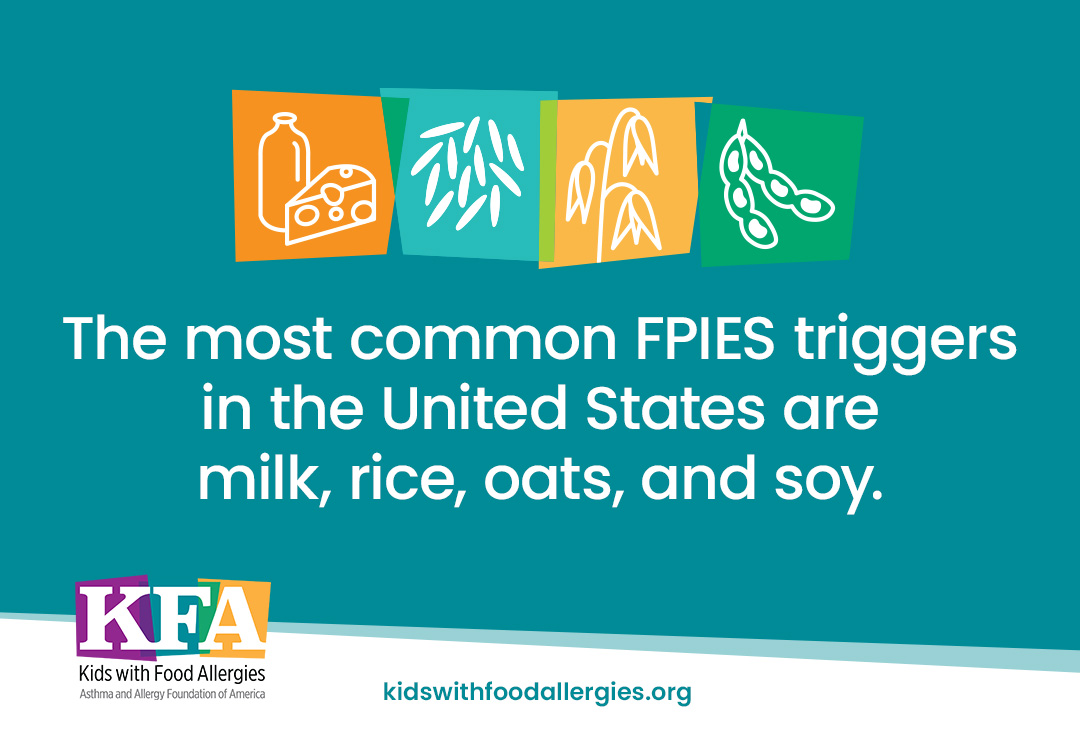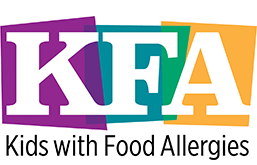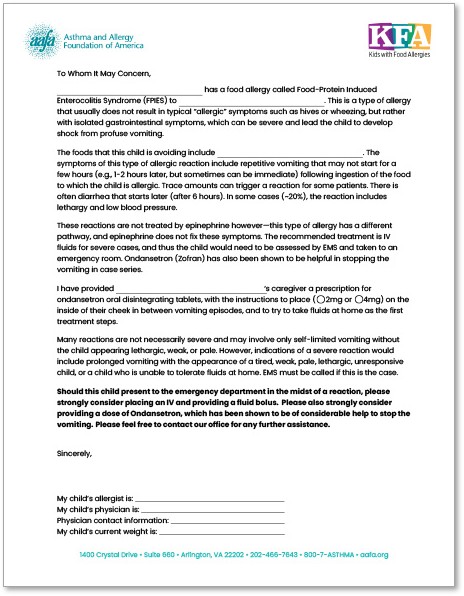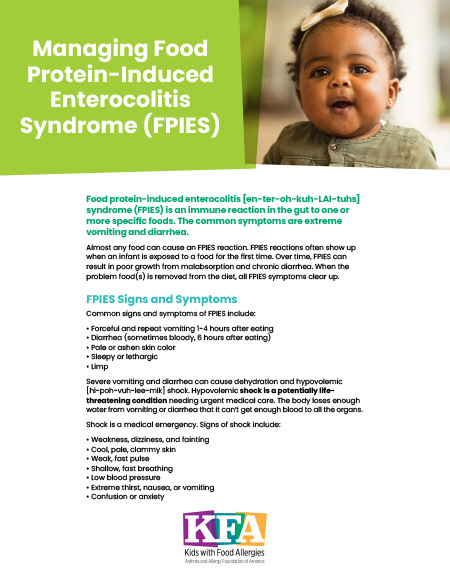Living with Food Allergies

Food Protein-Induced Enterocolitis Syndrome (FPIES)
FPIES is food protein-induced enterocolitis syndrome. It is commonly pronounced “F-Pies,” as in “apple pies,”. Enterocolitis [en·ter·oh·kuh·LAI·tuhs] is inflammation involving both the small intestine and the large intestine (colon).
On this page:
What is FPIES?
Is FPIES a type of food allergy?
When do FPIES reactions happen?
What are the symptoms of an FPIES reaction?
What is shock and what are the symptoms?
What is the treatment for FPIES?
What are common FPIES triggers?
How do doctors diagnose FPIES?
How do you manage and prevent FPIES?
Is FPIES a life-long condition?
How do you know if a child has outgrown FPIES?
Does FPIES put a child at risk of developing other food allergies?
What Is FPIES?
FPIES is an immune reaction in the gut (gastrointestinal system) to one or more specific foods. The common symptoms are profuse vomiting and diarrhea.
FPIES does not involve an IgE antibody like a typical food allergy. FPIES involves other immune cells, but which one is not clear (e.g., cell-mediated).
The most common FPIES triggers are cow’s milk (dairy), rice, oat, and soy. However, any food can cause an FPIES reaction, even those not commonly considered allergens, such as starchy vegetables. Over time, if the person continues to eat their trigger food this can result in poor growth from malabsorption and chronic diarrhea. Upon removing the problem food(s) from the diet, all FPIES symptoms clear up.
Is FPIES a Type of Food Allergy? What Does IgE vs. Cell-Mediated Mean?
FPIES is a cell-mediated food allergy. Cell-mediated reactions are considered delayed hypersensitivity. They are sometimes called “non-IgE” allergy.
IgE stands for Immunoglobulin E. IgE is a type of antibody that drives the typical allergic reactions that most people think of when talking about “food allergy”. IgE-mediated reactions are immediate immune system reactions (e.g., “type 1 hypersensitivity”).
Mediated means “brought on by”. So IgE-mediated allergic reactions are brought on by IgE antibodies. Cell-mediated immune reactions are brought on by immune cells, not IgE antibodies.
When you have skin testing or blood testing for food allergies, it measures IgE antibody against a particular food. In FPIES, antibodies are not involved. Other immune cells are involved, which have yet to be well-identified. This means there is no diagnostic test for FPIES.
If you have FPIES, it is possible to also have IgE-mediated food allergy or other intolerances.
When Do FPIES Reactions Happen?
FPIES reactions often show up at the time when an infant is exposed to a food for the first time. With cow milk or soy in infant formula, this may occur as early as within the first weeks of life. For other foods such as grains, fruits, vegetables, peanuts, and eggs, it happens when the child starts eating those foods.
It is exceptionally rare for food proteins to pass through human milk and cause symptoms in the infant/toddler. An FPIES reaction is most likely to occur when the child has directly ingested the trigger food(s) themselves.
What Is a Typical FPIES Reaction?
The typical FPIES reaction involves a delayed onset of forceful, repetitive vomiting about 1-4 hours after eating the trigger food. The vomiting can occur in cycles spaced apart by a few minutes. Or it could be only a single cycle of vomiting. In a small percentage of children, bloody diarrhea can occur, usually starting 6 hours after the trigger food was eaten. The child may appear a bit pale (even ashen colored), sleepy or lethargic, and may even be a bit limp.
How severe a reaction may be is hard to tell, and past reaction severity does not always predict how severe (or not) the next one may be. This can depend on how much of the trigger food was eaten, among other things that can make a reaction more severe.
Signs of FPIES include:
- Forceful and repetitive vomiting 1-4 hours after eating
- Diarrhea (sometimes bloody)
- Pale or ashen skin color
- Sleepy or lethargic
- Limp
FPIES reactions do not have traditional symptoms of allergic reactions like itching, hives, swelling, coughing or wheezing. FPIES reactions only involve the gastrointestinal system. In severe cases, after repeatedly vomiting, children often begin vomiting bile. The severe vomiting and diarrhea can be bad enough to cause dehydration and even shock.
What Is Shock and What Are the Symptoms?
Shock is a potentially life-threatening condition. There are several different types of shock. In FPIES, patients can be at risk of hypovolemic [hi·poh·vuh·lee·mik] shock. Because of the vomiting or diarrhea, the body loses enough water that it can’t get enough blood to all the organs. Hypovolemic shock in FPIES is a critical condition needing urgent medical care. It can be reversed through IV fluids.
Signs of shock include:
- Weakness, dizziness and fainting
- Cool, pale, clammy skin
- Weak, fast pulse
- Shallow, fast breathing
- Low blood pressure
- Extreme thirst, nausea or vomiting
- Confusion or anxiety
How Do You Treat an FPIES Reaction?
Always follow your doctor’s emergency plan for your specific situation. Many children can be re-hydrated at home, and parents are often encouraged to try to do so. Infants often respond well to nursing/breastfeeding.
To help stop the vomiting, there is one medication called Zofran (ondansetron), which can be given at home or in the hospital. It is an anti-vomiting medicine. Zofran can be given by mouth as a dissolving tablet, or by a shot or intravenous infusion (IV) in the healthcare setting. Using Zofran early in FPIES vomiting has been shown to lower the chances of needing IV fluids. Zofran and at home feeding are the first options, and for mild to moderate reactions, this can be done at home. Even in mild to moderate reactions, it is not uncommon for the child to appear a bit sleepy, and perhaps even nap, but then wake up and feed normally.
For more severe FPIES reactions, emergency care is needed when the:
- Vomiting does not respond to Zofran (if used)
- Vomiting leads to dehydration (with or without Zofran use)
- Child appears unusually lethargic or non-responsive, or
- Child cannot or refuses to take fluids at home
If your child is experiencing symptoms of severe FPIES or shock, contact your local emergency services (911) right away. If you are uncertain if your child is in need of emergency services, contact 911 or your doctor for guidance. The most critical treatment during an FPIES reaction is IV fluids. This can rapidly reverse the trend towards shock from the vomiting/diarrhea. Children experiencing more severe symptoms may require in-hospital monitoring (such as an admission overnight).
Can FPIES be treated with epinephrine?
Unlike IgE-mediated allergy, FPIES reactions are not treated with epinephrine. None of the symptoms in FPIES would be fixed by epinephrine. The shock in anaphylaxis is different than the shock in FPIES.
What Are Some Common FPIES Triggers?
The most common FPIES triggers in the United States are:
- Dairy (milk)
- Rice
- Oat
- Soy (although this is decreasing)
Other common FPIES triggers include:
- Wheat
- Barley
- Green beans
- Peas
- Sweet or white potatoes
- Squash (and other starchy vegetables)
- Poultry
- Egg
- Peanut
- Banana
- Seafood (growing trend for FPIES in adults)
These are just the most common foods, but any food could trigger FPIES, in theory.
Most persons have FPIES to just one food, but a small percentage may react to 2 or more foods. A reaction to one food does not mean that other foods will be an issue. There is no known risk of cross-reactivity between foods. A 2016 study from Australia found some very weak patterns in patients, but none strong enough to recommend avoidance.
The 2017 FPIES guidelines include a chart that helps prioritize introduction of particular foods after the initial FPIES case (or cases) to help make sure the child is getting proper nutrition.1 This may place lower priority on early introduction of certain allergens. So instead of trying certain foods at 4-6 months old, you start with other staple foods first before trying common FPIES triggers later in the first year of life.

How Is FPIES Diagnosed?
FPIES is difficult to diagnose. There are no tests—doctors make the diagnosis entirely by symptoms.
Part of why an FPIES reaction can be hard to spot is that the vomiting may look like someone has a stomach bug.
The difference in someone having a virus vs. FPIES is that symptoms starts a couple hours after the offending food is given, the child will not have a fever or other symptoms, and no one else in the house will be ill.
Many parents have rushed their children to the ER, limp from being dehydrated due to extreme, repeated projectile vomiting, only to be told, “It’s the stomach flu.” However, there are key differences between FPIES and a stomach bug.
Compare FPIES to stomach bug:
| Feature | FPIES | Stomach bug |
| Cause | Abnormal immune response to a specific food | An infection from viruses or bacteria in the stomach and gut |
| When symptoms start | Delayed 1-6 hours after eating the food | Immediate onset after eating contaminated food or soon after exposure to sick person |
| Symptoms | Severe, repeat vomiting More rarely, diarrhea ( can be bloody) Pale appearance Limp Tired/lethargic |
Nausea Vomiting Stomach cramps Watery diarrhea May include muscle aches or headache |
| Fever | No | Maybe |
| How long it lasts | Typically resolves in a few hours after the food has been digested | Typically lasts a few days |
| Does it come back | Eating the trigger food will cause the symptoms to return | Symptoms do not return after recovery |
| Contagious | No | Other people in the household may also be sick |
The most accurate way to diagnose FPIES is through an oral food challenge, which can be done to prove that:
- A trigger causes FPIES
- A potential trigger is safe after developing FPIES to another food, or
- FPIES has been outgrown
Not all allergist offices offer FPIES challenges—this means you may have to travel to a regional referral center in some areas.
FPIES oral challenges involve eating around 0.3g of food protein per kg of the patient’s weight, though some centers may start lower based on perceived risk. For example, cow’s milk has 1g milk protein per ounce, so in challenging a 10kg child, the challenge dose would be 3g, or 3oz. This can be fed in a single dose, or divided into a few equal portions and fed over 30-45 minutes. The child is then observed for symptoms for up to approximately 4 hours after finishing the dose. Some centers may choose to place an IV beforehand as a precaution, and some may even use hospital rooms for the procedure. Like challenges for IgE-mediated allergy, these are always done at the office of a highly experienced and trained clinician who can recognize FPIES symptoms and treat. The patient generally can be “cleared” of FPIES or risk of FPIES to that food if they tolerate the dose. However, for a small number of children, FPIES may present only after a few exposures to the food. Careful watching at home may be needed after tolerating an in-office trial of a food.
Can an IgE food allergy test help with FPIES diagnosis?
FPIES is not brought on by IgE antibodies, so food allergy tests do not help diagnose FPIES.
A 2014 study suggested that patients with positive allergy tests to their FPIES trigger may have a longer duration of their FPIES. But more recent meta-analysis (a type of study that sums up all the evidence on a topic) did not find any evidence of this after looking at 34 studies. A patient may very well have a positive allergy test to a trigger or other foods, but this may just be because they are prone to making positive allergy tests (e.g., atopic) and not have any harmful effects.
How Is FPIES Diagnosed?
FPIES is difficult to diagnose. There are no tests—doctors make the diagnosis entirely by symptoms.
Part of why an FPIES reaction can be hard to spot is that the vomiting may look like someone has a stomach bug.
The difference in someone having a virus vs. FPIES is that symptoms starts a couple hours after the offending food is given, the child will not have a fever or other symptoms, and no one else in the house will be ill.
Many parents have rushed their children to the ER, limp from being dehydrated due to extreme, repeated projectile vomiting, only to be told, “It’s the stomach flu.” However, there are key differences between FPIES and a stomach bug.
Compare FPIES to stomach bug:
FPIES
- Caused by an abnormal immune response to a specific food
- Symptoms are delayed 1-6 hours after eating the food
- Symptoms include severe, repeat vomiting; more rarely, diarrhea (can be bloody); pale appearance; limp; tired/lethargic
- There is no fever
- Typically resolves in a few hours after the food has been digested
- Eating the trigger food will cause the symptoms to return
- Is not contagious
Stomach bug
- Caused by an infection from viruses or bacteria in the stomach and gut
- Immediate onset of symptoms after eating contaminated food or soon after exposure to a sick person
- Symptoms include nausea, vomiting, stomach cramps, water diarrhea, may include muscle aches or headache
- There may be a fever
- Typically last a few days
- Symptoms do not return after recovery
- Other people in the household may also be sick
The most accurate way to diagnose FPIES is through an oral food challenge, which can be done to prove that:
- A trigger causes FPIES
- A potential trigger is safe after developing FPIES to another food, or
- FPIES has been outgrown
Not all allergist offices offer FPIES challenges—this means you may have to travel to a regional referral center in some areas.
FPIES oral challenges involve eating around 0.3g of food protein per kg of the patient’s weight, though some centers may start lower based on perceived risk. For example, cow’s milk has 1g milk protein per ounce, so in challenging a 10kg child, the challenge dose would be 3g, or 3oz. This can be fed in a single dose, or divided into a few equal portions and fed over 30-45 minutes. The child is then observed for symptoms for up to approximately 4 hours after finishing the dose. Some centers may choose to place an IV beforehand as a precaution, and some may even use hospital rooms for the procedure. Like challenges for IgE-mediated allergy, these are always done at the office of a highly experienced and trained clinician who can recognize FPIES symptoms and treat. The patient generally can be “cleared” of FPIES or risk of FPIES to that food if they tolerate the dose. However, for a small number of children, FPIES may present only after a few exposures to the food. Careful watching at home may be needed after tolerating an in-office trial of a food.
Can an IgE food allergy test help with FPIES diagnosis?
FPIES is not brought on by IgE antibodies, so food allergy tests do not help diagnose FPIES.
A 2014 study suggested that patients with positive allergy tests to their FPIES trigger may have a longer duration of their FPIES. But more recent meta-analysis (a type of study that sums up all the evidence on a topic) did not find any evidence of this after looking at 34 studies. A patient may very well have a positive allergy test to a trigger or other foods, but this may just be because they are prone to making positive allergy tests (e.g., atopic) and not have any harmful effects.
How Do You Care for a Child With FPIES?
Avoidance of the known trigger(s) is the main strategy to manage FPIES. However, practices can vary, depending on the patient, their specific reactions, and the treating clinician’s experience. In the past, patients may have been told to avoid additional foods beyond their known triggers. This practice is very outdated. Avoiding foods unnecessarily may worsen the risk for developing an IgE-mediated food allergy. It is now more common to offer food challenge to test tolerance of the other common FPIES triggers.
Most cow’s milk FPIES cases will tolerate extensively hydrolyzed milk based formulas, but some may need elemental formula. Most children will do well with human (breast) milk. Other children who have fewer triggers may just strictly avoid the offending food(s).
As mentioned above, new foods are usually introduced very slowly, one food at a time, for an extended period of time per food. Some doctors recommend trialing a single food for up to three weeks before introducing another. The 2017 FPIES guidelines offers a chart to help better prioritize certain food introductions to maximize the child’s nutrition. It takes into account having a varied diet and also having early allergens introduced in the first year of life.1
Emergency care plan for someone with FPIES
Because it’s a rare, but serious condition, in the event of an emergency, it is vital to get the correct treatment. Most doctors provide their patients with a letter containing a brief description of FPIES and its proper treatment. No FPIES action plan has been developed as of yet. In the event of a reaction, this letter can be taken to the ER with the child.
Is FPIES a Lifelong Condition?
Typically, no. Many children outgrow FPIES between 12-36 months after their first reaction, though it can vary. Milk and soy more closely fit an 18-24 month window, and solid foods closer to 24-36 months. Note, however, that the time varies per individual and the offending food, so statistics are a guide, but not an absolute. As mentioned above, one 2014 study coined the term “atypical FPIES” to describe children with FPIES and positive allergy testing to the trigger food, and felt that these children took longer to outgrow FPIES. However, this finding has not been repeated in other studies. A very small percentage will continue to have FPIES into their teenage years. Adults can also develop new-onset FPIES, and it is unclear how long such cases last.
How Do I know If My Child Has Outgrown FPIES?
Together with your child’s doctor, you should determine if/when to consider a food challenge. Using the 18-24 month guideline for milk/soy and 24-36 month guideline for other foods since last reaction is a starting place. The time will be up to you and your allergist. In the event of an unintended exposure to the food at home that was tolerated, assuming that enough protein (0.3g/kg weight) was eaten may count. There are a small percentage of children that will tolerate the initial re-introduction, but then possibly react again with additional trials, as is seen with diagnosis.
If My Child Has FPIES, Will They Develop IgE-Mediated Food Allergy To That or Other Triggers?
This is unlikely. In the recent meta-analysis that looked at 14 studies in 935 patients, about 1% (or 1 out of 100) patients developed an IgE-mediated allergy to the food after having FPIES.2
On rare occasion, cases have been reported where a child was having an oral food challenge for FPIES, and had a more traditional IgE-mediated reaction. The reverse is true as well—patients undergoing a challenge for IgE-mediated reaction have had FPIES reactions.
Medical Review: September 2025 by Matthew Greenhawt, MD, MBA, MSc
References
- Nowak-Węgrzyn, A., Chehade, M., Groetch, M. E., Spergel, J. M., Wood, R. A., Allen, K., Atkins, D., Bahna, S., Barad, A. V., Berin, C., Brown Whitehorn, T., Burks, A. W., Caubet, J. C., Cianferoni, A., Conte, M., Davis, C., Fiocchi, A., Grimshaw, K., Gupta, R., Hofmeister, B., … Greenhawt, M. (2017). International consensus guidelines for the diagnosis and management of food protein-induced enterocolitis syndrome: Executive summary-Workgroup Report of the Adverse Reactions to Foods Committee, American Academy of Allergy, Asthma & Immunology. The Journal of allergy and clinical immunology, 139(4), 1111–1126.e4. https://doi.org/10.1016/j.jaci.2016.12.966
- Phelan, A. K., Infante, S., Barni, S., Nurmatov, U., Boyle, R. J., & Vazquez-Ortiz, M. (2025). The Role of IgE Sensitization in Acute FPIES: A Systematic Review and Meta-Analysis. The Journal of Allergy and Clinical Immunology. In Practice, 13(4), 861–884.e3. https://doi.org/10.1016/j.jaip.2025.01.016














